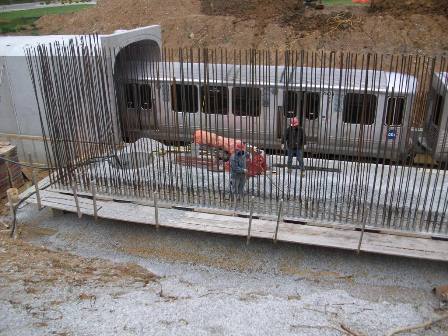Written in collaboration with G. Doug Roberts, Superintendent
K-Con is known for being one of the premier pre-engineered metal building general contractors for the Federal government. But sometimes, it’s just FUN to use our depth of experience and design-build capabilities to do some unique projects along the way.
One such project was for a subway simulation training facility at Muscatatuck Urban Training Center in Indiana. K-Con was awarded this design-build project and began work in November 2010. The project, slated to be complete in July of 2011, will be able to train military, FEMA, and first responders at a facility designed exclusively for that purpose in a realistic setting and scenario training. Earthquakes, floods, fires, and any number of natural disasters will all be addressed at the new facility, as well as acts of terrorism and chemical and biological attacks. In short, the new permanent subway training facility will be a boon for the National Guard and many other agencies in honing their skills and increasing emergency preparedness.
MUTC, formerly a State Developmental Center, was turned over to the Indiana Army National Guard (INARNG) in 2005 to be used as an urban training center for military and civilian first responder personnel. The training provided at MUTC can be tailored to replicate both foreign and domestic scenarios and can be utilized by various civilian and military organizations. In its first year of operation, the facilities at MUTC were utilized by over 16,000 individuals from military, government, and private agencies, and it is continually expanding its training capabilities for future needs.
So what are the challenges in building a simulated subway? The same difficulties and safety concerns associated with an underground structure were always present. However, the weather proved to be the most significant obstacle. K-Con considered that we were working during April in Indiana with its characteristic overcast, rainy climate, but we could not prepare for the amount or severity of the rain. Indiana experienced its wettest April since 1895, nearly tripling the annual average. And from February to April, the Hoosier state received the most precipitation in its history. Every day began with multiple temporary pumps removing water throughout the day and occasionally through the night. The near-constant rainfall, despite the great inconveniences and delays it brought with it, did allow us to see how well the drainage system we installed worked in the worst possible conditions.
Everything drains to the manhole or “crock” at the project’s south end in order for the permanent pumps to send it on to the storm sewer. That crock goes down another 12 feet from the bottom of the loading platform. We started digging and got about six feet down and hit solid bedrock. Unfortunately, the geotechnical report only went down to the lowermost part of the tunnel and did not consider that there would be digging any deeper for the manhole. This required us to get a ram hoe and, inch by inch, make our way to the bottom. Several other hurdles arose occasionally, but hurdles were made to be jumped. Things like national-level exercises and daily operations of the base were easily overcome with simple coordination with Operations. Getting a 300-ton crane set in order to place the cars and precast structures in place took a bit more coordination, energy, time, and sometimes research.
All in all, it has been a challenging project, but overcoming difficulties always proves to be its own reward, and anything can be overcome. You just can’t be afraid to get your feet wet.
For further information visit their web site at: https://www.in.gov/indiana-national-guard/muscatatuck-urban-training-center/





